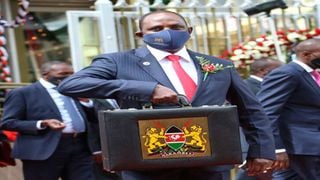
Treasury Cabinet Secretary Ukur Yatani displays the budget briefcase at The Treasury before leaving for Parliament Buildings for the reading of 2021/2022 annual budget on June 10, 2021.
| Sila Kiplagat | Nation Media GroupBusiness
Premium
Kenya spending five times what it invests, says Controller of Budget
What you need to know:
- Recurrent spending has risen to more than 460 per cent compared to development expenditure.
- The national government spent a total of Sh1.27 trillion between July and December.
Kenya is spending five times on consumption compared to funding development activities, Controller of Budget Margaret Nyakang’o has said.
A huge wage bill, a growing public debt, pending bills and pensions are some of the factors that have left the state draining 82 per cent of its resources on recurrent activities.
This has led to a situation where recurrent spending has risen to more than 460 per cent compared to development expenditure.
This has denied the government room to focus on things that would catalyse economic growth, the Controller of Budget says in her latest report on the national government’s budget implementation for the period between July and December 2021.
Dr Nyakang’o notes that while the cumulative spending by the national and county governments in the first half of 2021/22 was Sh1.4 trillion, spending on recurrent activities totalled Sh1.2 trillion, with spending on development activities taking up only Sh257 billion.
The national government spent a total of Sh1.27 trillion between July and December, out of which only Sh231 billion went into funding development projects, while Sh1.06 trillion was spent on salaries, travel, pensions and debts.
“Total exchequer issues towards MDAs (Ministries, Departments and Agencies) recurrent expenditure in the first half of the FY 2021/22 amounted to Sh528.05 billion, representing 47.7 per cent of the net estimates,” Dr Nyakang’o stated in the report.
Recurrent spending
This is a Sh68 billion (15 per cent) growth in the recurrent spending compared to a similar period last year, when the government spent Sh459.7 billion to finance recurrent activities.
The Consolidated Fund Services (CFS) – the account from which public debt, pensions and salaries of constitutional office holders are paid – spent Sh68.4 billion (17 per cent) more compared to the six months between July and December 2021, with money spent servicing the public debt exceeding the entire amount spent to fund CFS over a similar period last year.
The government between July and December 2021 spent Sh396 billion on debts, Sh65 billion on pensions and Sh1.4 billion on salaries and allowances for constitutional officeholders.
“This is attributed to an increase in domestic debt interest payment and pension and gratuity payment, which could be due to changing dynamics on the government’s overall debt structure and payment to the public service superannuation scheme,” Dr Nyakang’o stated.
COB reports that the government’s spending on recurrent activities is growing, as pending bills pile due to a growing inability to pay for services rendered to facilitate development, a situation that is leading to stalling of development projects even as consumption in government grows, effectively turning the country into a consumption economy.
In the counties, while a total of Sh159.5 billion was spent between July and December, only Sh25.9 billion (16 per cent) was committed to development. This means counties spent 5.1 times on recurrent activities compared to development (or 515 per cent).
The COB reported that while counties consumed 41.1 per cent of their estimated recurrent expenditure during the period, only 13.5 per cent of the estimated development expenditure was utilised.
Public debt
National government’s spending on development programmes, however, increased by a meagre Sh35 million (0.15 per cent) between the two periods, from Sh230.89 billion to Sh231.24 billion.
Among MDAs that spent more on development compared to recurrent are the state departments for Arid and Semi-Arid Areas (Asals), Sports and Gender.
Overall, the national and county governments spent Sh1.45 trillion in the half-year, compared to Sh1.31 trillion during a similar period last year. This is a Sh141 billion (11 per cent) growth.
According to the 2021/22 budget, the country is expected spend a total of Sh3.6 trillion, comprising Sh1.27 trillion for MDAs’ recurrent expenditure, Sh668 billion for development, Sh1.33 trillion for CFS and Sh370 billion as equitable share to the counties.
In the report, the CoB faults the government for diverting cash meant for development projects, in disregard of estimates passed in Parliament, thus affecting implementation of development projects.
“The OCOB has consistently reported on deviations that arise during budget implementation by MDAs in the form of additions to approved estimates. The Office of the Controller of Budget continues to urge all the MDAs to stick to Parliament-approved estimates in the implementation of their programmes and activities. Specifically, the implementation of long-term development projects should follow the approved work plans and cash-flow projections,” it stated.
Dr Nyakang’o highlighted delayed project implementation, growth in public debt, low absorption of development expenditure budget and huge pending bills as some of the main hindrances to budget implementation.





